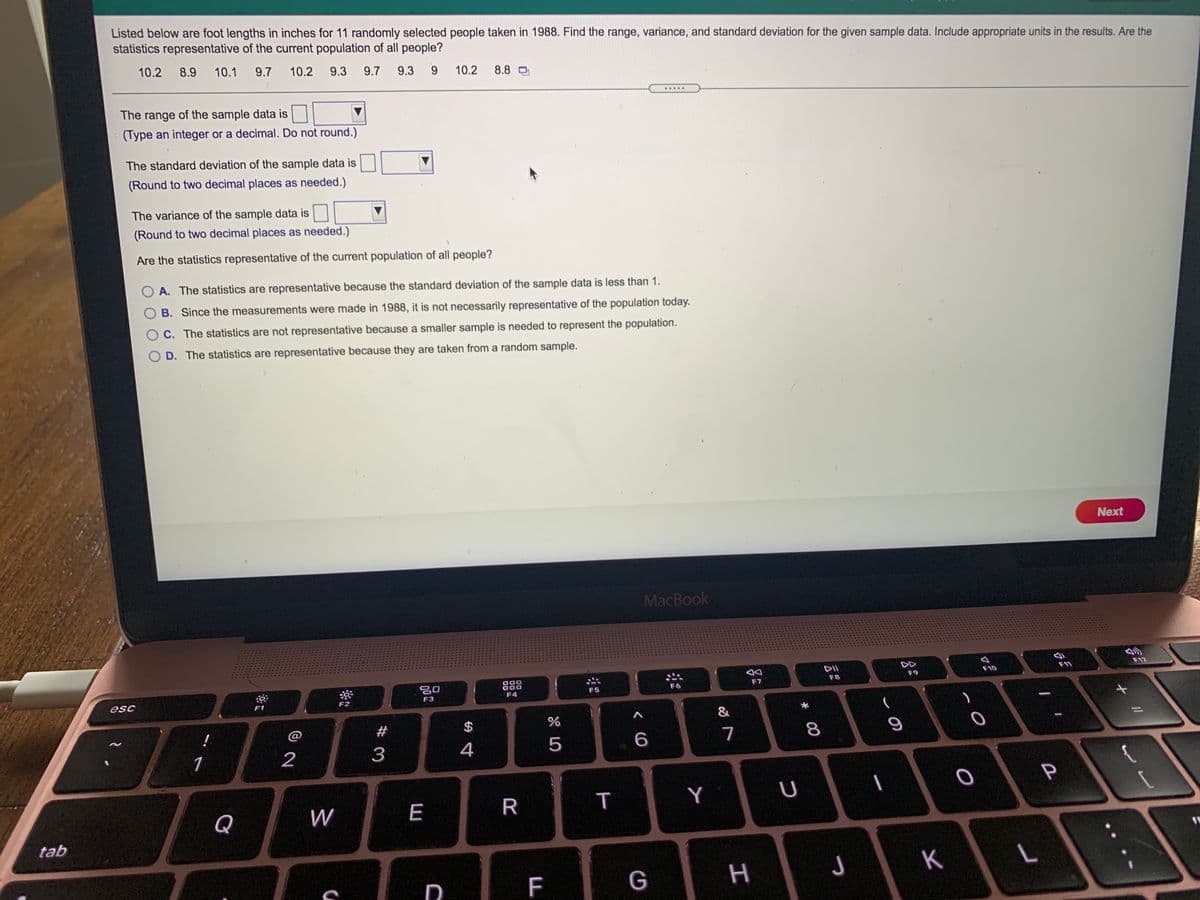Listed below are foot lengths in inches for 11 randomly selected people taken in 1988. Find the range, variance, and standard deviation for the given sample data. Include appropriate units in the results. Are the statistics representative of the current population of all people? 10.2 8.9 10.1 9.7 10.2 9.3 9.7 9.3 9. 10.2 8.8 D The range of the sample data is (Type an integer or a decimal. Do not round.) The standard deviation of the sample data is (Round to two decimal places as needed.) The variance of the sample data is (Round to two decimal places as needed.) Are the statistics representative of the current population of all people? O A. The statistics are representative because the standard deviation of the sample data is less than 1. O B. Since the measurements were made in 1988, it is not necessarily representative of the population today. O C. The statistics are not representative because a smaller sample is needed to represent the population. random sample. O D. The statistics are representative because they are taken from
Listed below are foot lengths in inches for 11 randomly selected people taken in 1988. Find the range, variance, and standard deviation for the given sample data. Include appropriate units in the results. Are the statistics representative of the current population of all people? 10.2 8.9 10.1 9.7 10.2 9.3 9.7 9.3 9. 10.2 8.8 D The range of the sample data is (Type an integer or a decimal. Do not round.) The standard deviation of the sample data is (Round to two decimal places as needed.) The variance of the sample data is (Round to two decimal places as needed.) Are the statistics representative of the current population of all people? O A. The statistics are representative because the standard deviation of the sample data is less than 1. O B. Since the measurements were made in 1988, it is not necessarily representative of the population today. O C. The statistics are not representative because a smaller sample is needed to represent the population. random sample. O D. The statistics are representative because they are taken from
Glencoe Algebra 1, Student Edition, 9780079039897, 0079039898, 2018
18th Edition
ISBN:9780079039897
Author:Carter
Publisher:Carter
Chapter10: Statistics
Section10.4: Distributions Of Data
Problem 19PFA
Related questions
Question
Drop down options for all: Inches, people, inches2, people2

Transcribed Image Text:Listed below are foot lengths in inches for 11 randomly selected people taken in 1988. Find the range, variance, and standard deviation for the given sample data. Include appropriate units in the results. Are the
statistics representative of the current population of all people?
10.2 8.9
10.1 9.7
10.2
9.3
9.7
9.3
9.
10.2
8.8 O
.....
The range of the sample data is
(Type an integer or a decimal. Do not round.)
The standard deviation of the sample data is
(Round to two decimal places as needed.)
The variance of the sample data is
(Round to two decimal places as needed.)
Are the statistics representative of the current population of all people?
A. The statistics are representative because the standard deviation of the sample data is less than 1.
O B. Since the measurements were made in 1988, it is not necessarily representative of the population today.
C. The statistics are not representative because a smaller sample is needed to represent the population.
D. The statistics are representative because they are taken from a random sample.
Next
MacBook
DII
DD
F12
F10
F11
F9
888
OC
000
F8
F6
F7
F5
F3
F4
esc
F1
F2
&
@
#
$
4
5
7
1
2
3
Y
Q
W
E
tab
G
H
J
K
F
00
R
Expert Solution
This question has been solved!
Explore an expertly crafted, step-by-step solution for a thorough understanding of key concepts.
This is a popular solution!
Trending now
This is a popular solution!
Step by step
Solved in 2 steps with 2 images

Recommended textbooks for you

Glencoe Algebra 1, Student Edition, 9780079039897…
Algebra
ISBN:
9780079039897
Author:
Carter
Publisher:
McGraw Hill

Glencoe Algebra 1, Student Edition, 9780079039897…
Algebra
ISBN:
9780079039897
Author:
Carter
Publisher:
McGraw Hill